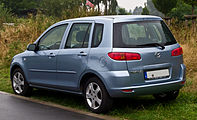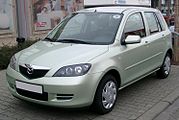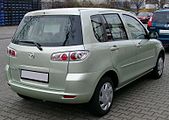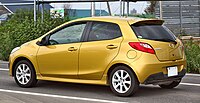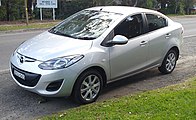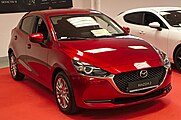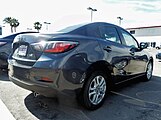Mazda2
| Mazda 2 | |
|---|---|
| Production period: | since 2003 |
| Class : | Small car , minivan |
| Body versions : | Sedan , hatchback , station wagon |
| Previous model: |
Mazda 121 Mazda Demio |
The Mazda2 is a front-wheel drive compact car from the Japanese manufacturer Mazda , which has been built since spring 2003 and has been in its third generation since autumn 2014.
It is the successor to the Mazda Demio in Europe , while the latter is still being built and sold in some countries. In the manufacturer's model range, it is placed at the lower end below the Mazda3 .
2 (type DY, 2003-2007)
| 1st generation | |
|---|---|
|
Mazda2 (2003-2005) |
|
| Production period: | 2003-2007 |
| Body versions : | Station wagon |
| Engines: |
Otto engines : 1.2–1.6 liters (55–74 kW) Diesel engines : 1.4 liters (50 kW) |
| Length: | 3952 mm |
| Width: | 1680 mm |
| Height: | 1530 mm |
| Wheelbase : | 2490 mm |
| Empty weight : | 1125-1207 kg |
The first generation of the Mazda2, introduced in April 2003, was based on the platform of the Ford Fiesta '02 and the design was based on the predecessor, the Mazda Demio . A striking external feature of the Mazda2 was the high passenger cell, which was still atypical for a small car at the time, and which was more reminiscent of a minivan . It was built in the Spanish Ford factory Almussafes near Valencia .
In the spring of 2005 there was a slight facelift in which headlights and aprons were upgraded and new fabrics and colors were used. There were also new clear glass rear lights and modified, smaller fog lights.
Engines
In the course of the model cycle, the engines and transmission variants were repeatedly revised slightly. The automated manual transmission was also available in the 1.4-liter MZ-CD diesel until 2006. In addition, the same engine has complied with the Euro 4 emissions standard since the facelift in 2005 thanks to a new control unit.
| model | Displacement | power | Torque | transmission | construction time |
|---|---|---|---|---|---|
| Petrol engines | |||||
| 1.25 MZI | 1242 cc | 55 kW (75 hp) at 6000 min -1 | 110 Nm at 4000 min -1 | Five-speed manual transmission | 2003-2007 |
| 1.4 MZI | 1388 cc | 59 kW (80 hp) at 5700 min -1 | 124 Nm at 3500 min -1 | Five-speed manual or automated five-speed transmission |
2003-2007 |
| 1.6 MZI | 1596 cc | 74 kW (101 hp) at 6000 min -1 | 146 Nm at 4000 min -1 | Five-speed manual transmission | 2003-2007 |
| Diesel engine | |||||
| 1.4 MZ- CD | 1399 cc | 50 kW (68 hp) at 4000 min -1 | 160 Nm at 2000 min -1 | Five-speed manual or automated five-speed transmission |
2003-2007 |
2 (type DE, 2007-2014)
| 2nd generation | |
|---|---|
|
Mazda2 (2007-2010) |
|
| Production period: | 2007-2014 |
| Body versions : | Station wagon , sedan |
| Engines: |
Otto engines : 1.3–1.5 liters (55–76 kW) Diesel engines : 1.4–1.6 liters (50–70 kW) |
| Length: | 3885-3920 mm |
| Width: | 1695 mm |
| Height: | 1475 mm |
| Wheelbase : | 2490 mm |
| Empty weight : | 954-1035 kg |
| Stars in the Euro NCAP - Crash Test |
|
On October 20, 2007, the second generation of the Mazda2 was launched in Germany. "Downsizing" made this four centimeters shorter and was based on a new platform that the Mazda shares with the Ford Fiesta from 2008 onwards.
Ujina in Hiroshima, Japan, was selected as the production site , where the first vehicle rolled off the assembly line on May 22, 2007. In contrast to the box-shaped first generation, the new model was a purely small car with no optical borrowings from a minivan . In addition to the shorter length of 3.88 meters, the weight was also reduced by around 100 kg, which should also reduce fuel consumption. Depending on the position of the seat backrests, the trunk volume was 250 to 787 liters (trunk volume, l according to VDA / folded second row of seats, roof-high); six airbags and ESP were standard.
At the start of sales, Mazda initially only offered a five-door version. A three-door model called Mazda2 Sport followed at the Geneva Motor Show in 2008 and was sold from June of that year.
The prices started at 11,950 euros (Mazda2 Sport) and 12,650 euros (Mazda2) for the basic version Impulse and were thus slightly below those of the previous generation. In addition to the base, there was also the Independence and Impression equipment .
At the beginning of 2008, a notchback version mainly intended for the Chinese market was launched. This was presented at the Guangzhou Auto Show on November 20, 2007. By extending the rear end by 37 centimeters, the trunk volume increased to 450 liters. The two larger gasoline engines and a four-speed automatic were available for the notchback.
From the beginning of 2009 the Mazda2 was also available with the "Dynamic" equipment variant, which was based on "Impression" and also contained a sport-look package.
In the late summer of 2010, the Mazda2 underwent a subtle facelift in which the front bumper was redesigned.
Production of the second generation ended in autumn 2014.
Engines
In addition to the newly developed gasoline engines with 1.3 or 1.5 liter displacement that have been available since the start of sales, a 50 kW (68 hp) 1.4-liter common-rail diesel engine was added in 2008. This was replaced in June 2009 by a new 66 kW (90 PS) 1.6-liter common rail diesel engine. All engines are in-line four-cylinder.
| model | Displacement | power | Torque | transmission | construction time | |
|---|---|---|---|---|---|---|
| Petrol engines | ||||||
| 1.3 MZR | 1349 cc | 55 kW (75 hp) at 6000 / min -1 | 119 Nm at 3500 / min -1 | Five-speed manual transmission | 05 / 2007-10 / 2014 | |
| 1.3 MZR | 1349 cc | 62 kW (84 HP) at 6000 / min -1 | 121 Nm at 3500 / min -1 | Five-speed manual transmission | 09/2010-10/2014 | |
| 1.3 MZR | 1349 cc | 63 kW (86 hp) at 6000 / min -1 | 122 Nm at 3500 / min -1 | Five-speed manual transmission | 05 / 2007-09 / 2010 | |
| 1.5 MZR | 1498 cc | 75 kW (102 hp) at 6000 / min -1 | 133 Nm at 4000 / min -1 | Five-speed manual transmission, 4-speed automatic transmission | 09/2010-10/2014 | |
| 1.5 MZR | 1498 cc | 76 kW (103 hp) at 6000 / min -1 | 137 Nm at 4000 rpm −1 | Five-speed manual transmission, 4-speed automatic | 05 / 2007-09 / 2010 | |
| Diesel engines | ||||||
| 1.4 MZ- CD | 1399 cc | 50 kW (68 hp) at 4000 / min -1 | 160 Nm at 2000 rpm −1 | Five-speed manual transmission | 05/2007 - 06/2009 | |
| 1.6 MZ-CD | 1560 cc | 66 kW (90 hp) at 4000 / min -1 | 212 Nm at 1750 rpm −1 | Five-speed manual transmission | 06/2009 - 09/2010 | |
| 1.6 MZ-CD | 1560 cc | 70 kW (95 hp) at 3800 / min -1 | 205 Nm at 1750-3000 / min -1 | Five-speed manual transmission | 09/2010 - 03/2014 | |
Electric drive
From October 2012, the Mazda2 (Demio) was also offered for the first time in Japan with an electric drive as part of a leasing program. The Mazda2 EV has an output of 75 kW (102 PS) and the range of the electric car should be 200 kilometers according to the Japanese JC08 driving cycle. In terms of space, the five-seater does not differ from the conventionally powered model.
2 (type DJ, since 2014)
| 3rd generation | |
|---|---|
|
Mazda2 (2014-2020) |
|
| Production period: | since 2014 |
| Body versions : | Station wagon , sedan |
| Engines: |
Otto engines : 1.5 liters (55–85 kW) Diesel engine : 1.5 liters (77 kW) |
| Length: | 4060-4065 mm |
| Width: | 1695 mm |
| Height: | 1495 mm |
| Wheelbase : | 2570 mm |
| Empty weight : | 970-1157 kg |
| Stars in the Euro NCAP - Crash Test (2015) |
|
The third generation of Mazda2 was presented at the Paris Motor Show in autumn 2014. In addition to a new look in Mazda's Kodo design - Kodo means something like "soul of movement" - the model has completely new engines based on the SkyActiv technology developed by Mazda .
The Mazda2 is produced at the Hofu plant in Japan and has been available in Europe only as a five-door hatchback sedan since January 2015 . In Germany, the sales premiere took place on February 27th and 28th; prices started at around € 12,800. Four equipment lines are offered.
The technology named by the manufacturer SkyActiv (since 2011) includes a compression of 14: 1, an engine block made of an aluminum alloy, multi-hole injectors and less friction. Mazda thus promises more torque at low speeds and lower fuel consumption. By February 2011, Mazda said it had applied for more than 130 patents. The turning circle is less than 10 meters.
In some Asian markets, a notchback version has been sold again since spring 2015.
Engines
At the market launch, there were three gasoline and one diesel engines to choose from, all with a displacement of 1.5 liters. The two weaker petrol engines are equipped with a manual 5-speed manual transmission, and a six-speed automatic transmission can also be selected for the 90 hp petrol engine. The two more powerful engines had a manual transmission with six gears. Mazda SKYACTIV technology "i-ELOOP" (Intelligent Energy Loop), a braking energy recovery system that is already available in the Mazda3 and Mazda6 , is available for the 85 kW petrol engine. It consists of a capacitor, a generator and a DC voltage converter. As soon as the vehicle is braked or no acceleration takes place, the generator converts the kinetic energy into electrical energy and stores it in a capacitor. This electrical energy supplies, among other things, the air conditioning and the audio system and should save up to 10% petrol.
The Skyactiv-D 105 diesel engine has not been available since August 2018.
Facelift
For the 2020 model year, the front section in particular has been revised. Most noticeable here are the now standard LED main headlights in a modified design. The taillights have also been changed slightly. In addition to the introduction of mild hybrid systems, the two remaining gasoline engines Skyactiv-G 75 and -G 90 receive a 6-speed manual transmission, whereas the previous Skyactiv-G 115 is no longer available. For the Skyactiv-G 90, a 6-stage automatic is still optionally available.
| Skyactiv-G 75 | Skyactiv-G 90 | Skyactiv-G 115 | Skyactiv-D 105 | |||
|---|---|---|---|---|---|---|
| Construction period | 11 / 2014–12 / 2019 | since 01/2020 | 11 / 2014–12 / 2019 | since 01/2020 | 11 / 2014–12 / 2019 | 11/2014–05/2018 |
| Engine type | R4 petrol engine | R4 diesel engine | ||||
| Mixture preparation | Direct petrol injection | Common rail direct injection | ||||
| Engine charging | - | turbocharger | ||||
| Displacement | 1496 cc | 1499 cc | ||||
| Max. power | 55 kW (75 PS) at 6000 rpm |
66 kW (90 PS) at 6000 rpm |
85 kW (115 PS) at 6000 rpm |
77 kW (105 PS) at 4000 rpm |
||
| Max. Torque | 135 Nm at 3800 rpm |
148 Nm at 4000 rpm |
148 Nm at 4000 rpm |
220 Nm at 1400-3200 rpm |
||
| Drive, as standard | Front wheel drive | |||||
|
Gearbox, as standard [optional] |
5-speed manual transmission | 6-speed manual transmission | 5-speed manual transmission [6-speed automatic transmission] |
6-speed manual transmission [6-speed automatic transmission] |
6-speed manual transmission | 6-speed manual transmission |
| Top speed | 171 km / h | 183 km / h [177 km / h] |
200 km / h | 178 km / h | ||
|
Acceleration, 0-100 km / h |
12.1 s | 11.4 s | 9.4 s [12.0 s] |
9.8 s [12.0 s] |
8.7 s | 10.1 s |
|
Fuel consumption over 100 km (combined) |
4.7-4.9 l super | 4.1 l super | 4.5–4.9 l super [4.8–5.2 l super] | 4.1 l super [5.2 l super] | 4.9–5.4 l super | 3.4 l diesel |
|
CO 2 emissions (combined) |
110-111 g / km | 94 g / km | 105–111 g / km [112–118 g / km] | 94 g / km [118 g / km] | 115-124 g / km | 89 g / km |
|
CO 2 emissions (combined according to WLTP cycle) |
124 g / km | 120 g / km | 124 g / km [133 g / km] | 120 g / km [133 g / km] | 127 g / km | - |
| Energy efficiency rating | C (as of July 30, 2018) | A. | C (as of July 30, 2018) | A [C] | C (as of July 30, 2018) | A + (as of Nov. 2014) |
|
Emission standard according to EU classification |
Euro 6 (since 07/2018: Euro 6d-TEMP) |
Euro 6d | Euro 6 (since 07/2018: Euro 6d-TEMP) |
Euro 6d | Euro 6 (since 07/2018: Euro 6d-TEMP) |
Euro 6 |
- Values in brackets apply to the automatic variant.
North America
On the North American market, the notchback variant was marketed as Scion iA from 2015 . After the Scion brand was discontinued in 2016, the model has since been available as the Toyota Yaris Sedan in the USA ( Toyota Yaris iA there until 2018 ) and Canada and as the Toyota Yaris R in Mexico. With the discontinuation of the Toyota Yaris (XP13) in North America in 2019, Toyota introduced the hatchback version of the Mazda2 as its successor in the US and Canada.
In Mexico, the series is also marketed by Mazda as a hatchback and sedan. The Toyota Yaris (XP15) is also available as a hatchback and sedan.
Registration numbers
Since the market launch in 2003 up to and including December 2019, a total of 176,527 Mazda2s have been newly registered in the Federal Republic of Germany. With 21,686 units, 2009 was by far the most successful sales year. This is due to the environmental bonus .
Individual evidence
- ↑ Crash test Mazda2 ( page can no longer be accessed , search in web archives ) Info: The link was automatically marked as defective. Please check the link according to the instructions and then remove this notice. (ADAC 12/2007)
- ↑ Auto-News online edition of January 25, 2008: "Mazda2 three-door: The Japanese are expanding their model range"
- ↑ Auto-News online edition of November 20, 2007: "China rear: Mazda 2 with stage for the Middle Kingdom"
- ↑ Mazda2 from 2015 ( Memento of the original from February 24, 2015 in the Internet Archive ) Info: The archive link was inserted automatically and has not yet been checked. Please check the original and archive link according to the instructions and then remove this notice.
- ↑ Spiegel-Online from May 5, 2009: "Fast restart in the niche"
- ↑ Green cars " Mazda 2 with electric drive starts in Japan in October 2012 "
- ↑ Result of the Mazda2 in the Euro NCAP crash test (2015)
- ↑ welt.de, test Mazda2 from August 20, 2017 , accessed on September 16, 2018.
- ↑ motorsport-total.com of March 25, 2017, Mazda CX-5 2017 ... , accessed on September 16, 2018.
- ↑ AutoZeitung.de of May 31, 2017, 3rd generation report , available on September 16, 2018.
- ^ English-language Mazda2 website from May 18, 2011 , accessed on September 16, 2018.
- ↑ a b c d Mazda2 price list from July 30, 2018, pages 8 and 9 (PDF, approx.2.5 MB in total) , accessed on September 16, 2018.
- ↑ www2.mazda.com/en of November 21, 2014, Mazda2 Notchback (English), available on September 16, 2018.
- ↑ Mazda brochures. In: Mazda Motors (Germany) GmbH. Mazda Motors (Deutschland) GmbH, January 2, 2019, accessed January 2, 2019 .
- ↑ Handelsblatt.com of November 7, 2014, small, but sporty-fine , under technical data; accessed on September 16, 2018.
- ↑ Steve Siler: 2016 Scion iA: A Mazda 2 Sedan with a Scion Badge. In: caranddriver.com. April 2, 2020, accessed on May 22, 2020 .
- ↑ Scott Oldham: 2020 Toyota Yaris Hatchback Goes Beyond Basic Transportation. In: caranddriver.com. May 17, 2020, accessed on May 22, 2020 .
- ↑ Patrick Lang: New Toyota Yaris (2020) for the USA: Small car debuts at the New York Auto Show. In: auto-motor-und-sport.de. April 2, 2019, accessed May 22, 2020 .
Web links
- Official website
- Short report on the 2nd generation of the Mazda2 at de.motor1 from February 11, 2007, available on January 19, 2019.
- Current news, prices and tests for the Mazda2 on autobild.de

